Make the ultimate homemade frozen treat by mastering how to make a custard ice cream base. Plus, the best vanilla frozen custard recipe, and a recovery hack for if the base curdles!
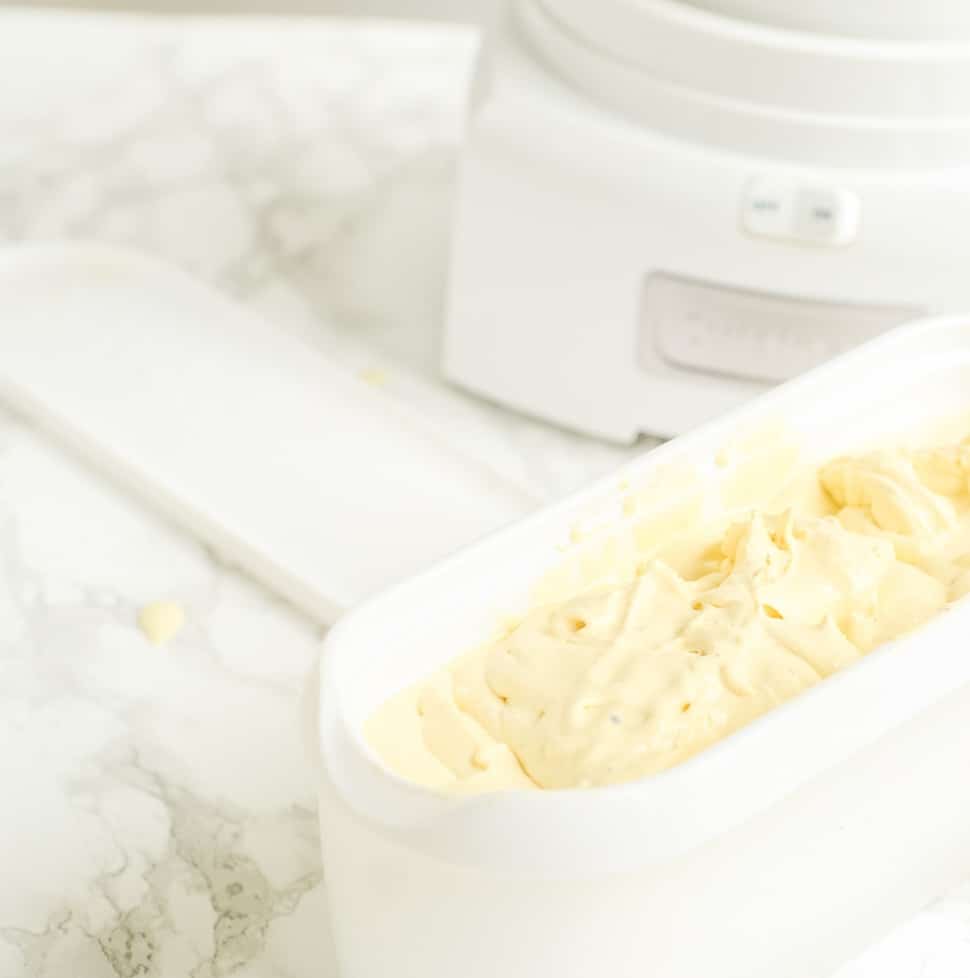
Let’s be honest from the beginning: making custard ice cream is time consuming. The results, however, are proof of the difficult work.
You get a creamy, dreamy, luxuriously smooth ice cream that begs to be eaten. It calls to you in your dream and whisks you away to pleasant places during the day. But more than anything, it tempts you to make poor choices about portion size.
What Is The Difference Between Frozen Custard and Ice Cream?
Custard and ice cream are made of the same three basic ingredients: milk, sugar, and cream. The difference between the two is that custard also has cooked egg yolks in it that provides a silkier texture. Depending on the recipe, standard ice cream may not be churned in an ice cream maker while custard always is.
Custard gives you the classic texture reminiscent of old fashioned ice cream; super smooth, thick, and decadent. Whether you’re making something fancy, or a classic vanilla ice cream recipe, a custard base gives you the best result! Plus, as an added bonus, custard ice creams don’t get freezer burnt as easily. This is because the water particles are fewer and smaller and the eggs work as an emulsifier to contain the water.
When To Use Frozen Custard
I would say that more than anything, it comes down to what kind of ice cream you’re making. The more luxurious and indulgent, the more likely to use custard.
Think of elegant or regal flavors that the custard will help bring out.
- vanilla bean
- dark chocolate
- dulce de leche
- salted caramel
- white chocolate.
It’s also nice to use a custard base when you’re adding in flavors with a high amount of water. ( Peach, mango, or lemon for example.) The egg yolks help capture the water and make the ice cream less watery.
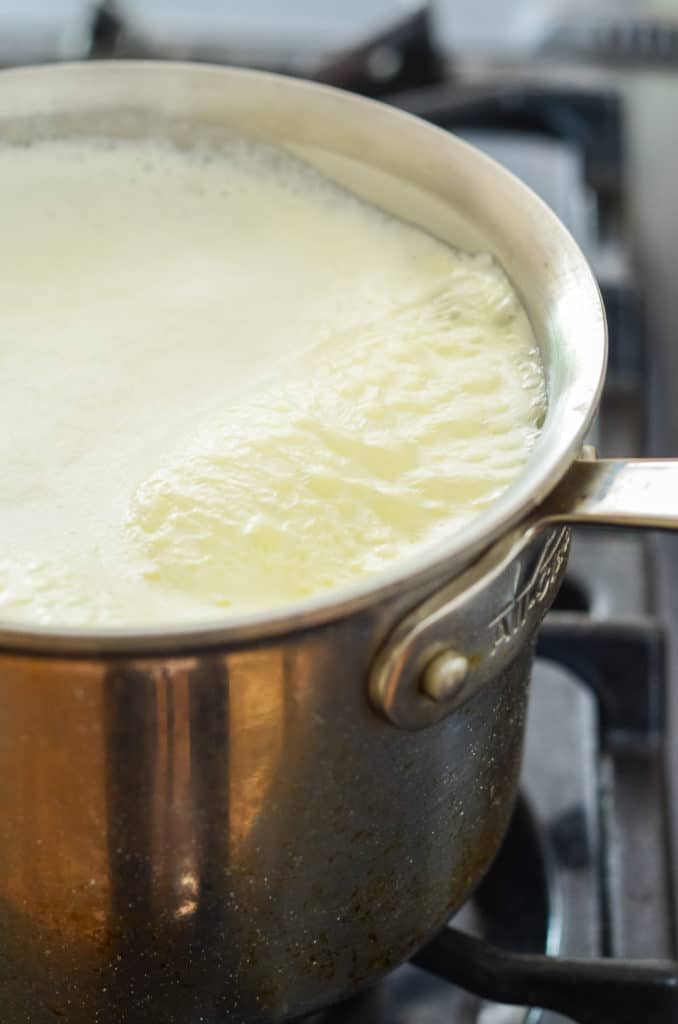
Using a Double Boiler
You don't have to own a fancy double boiler to make custard ice cream at home. A simple deep pot or saucepan with a glass bowl that fits tightly on top will do. (Avoid using a metal bowl, as it can discolor the egg yolks and make your ice cream dingy.)
The purpose of the double boiler is to cook the egg yolks without turning them into breakfast food. This is done by using trapped steam between the bowl and a small amount of water in the heavy saucepan.
If you're new to using a double boiler, I recommend medium low heat. If the water begins to go above a light simmer, you run the risk over overcooking the eggs. Again, this is a little time consuming, but it is so rewarding.
You only need an inch or two of water in the pot. Once the water is to the light simmer, your double boiler is ready to use.
Unlike some other recipes, this one uses the scalded milk mixture to begin cooking the eggs. This is called tempering. By slowly adding in the heated liquid, it begins the cooking process at a slow rate. Once it is all incorporated, the large bowl can be placed over the simmering water.
For the best results when using a double boiler, I recommend whisking constantly. However, there is a catch. As you whisk, it pushes the custard up onto the side of the bowl which cooks it. Whisk slowly and purposely to prevent this.
Once your custard ice cream base is cooked, remove the bowl from the heat. Stop the cooking process by adding in the cold cream and vanilla, stirring occasionally to help it cool. Now you're ready to strain the homemade ice cream, cover it with plastic wrap, and chill overnight.
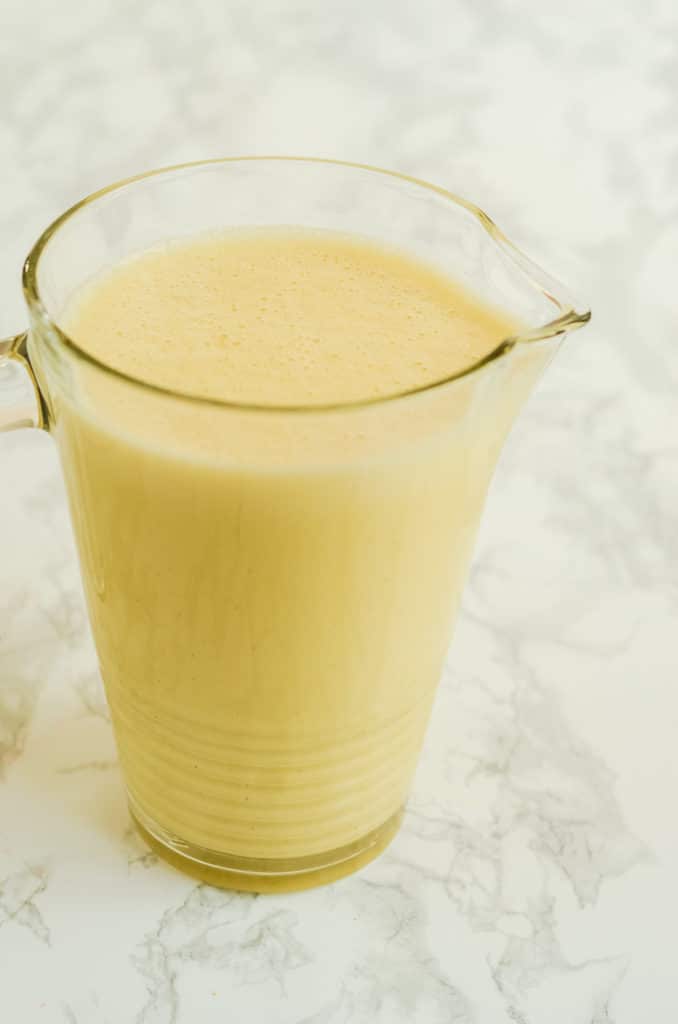
How To Recover Curdled Custard
Temperature control is key when preparing custard. There is a fine line between silky custard and scrambled eggs.
Tip: keeping a well-calibrated thermometer in the bowl at all times helps this. (You can double check the calibration by putting the thermometer in a glass of ice water. It should read 32°F.)
As soon as the temperature hits 160°F, shut off the heat and remove from the heat. If you let your custard base rest over the burner, the residual heat can take your base over that fine line.
If the unexpected happens and the eggs end up scrambled, all hope is not lost. I have a recovery hack that works excellently every single time.
To recover a curdled custard ice cream base cool the custard to room temperature. Place it in a blender and blend on medium-high for 15-30 seconds or until it is once again smooth.
Blending your curdled ice cream base breaks down the egg into teeny-tiny pieces so it won’t impact the texture. The ice cream may taste bit more “eggy” than if it hadn’t curdled. But nine times out of ten no one notices.
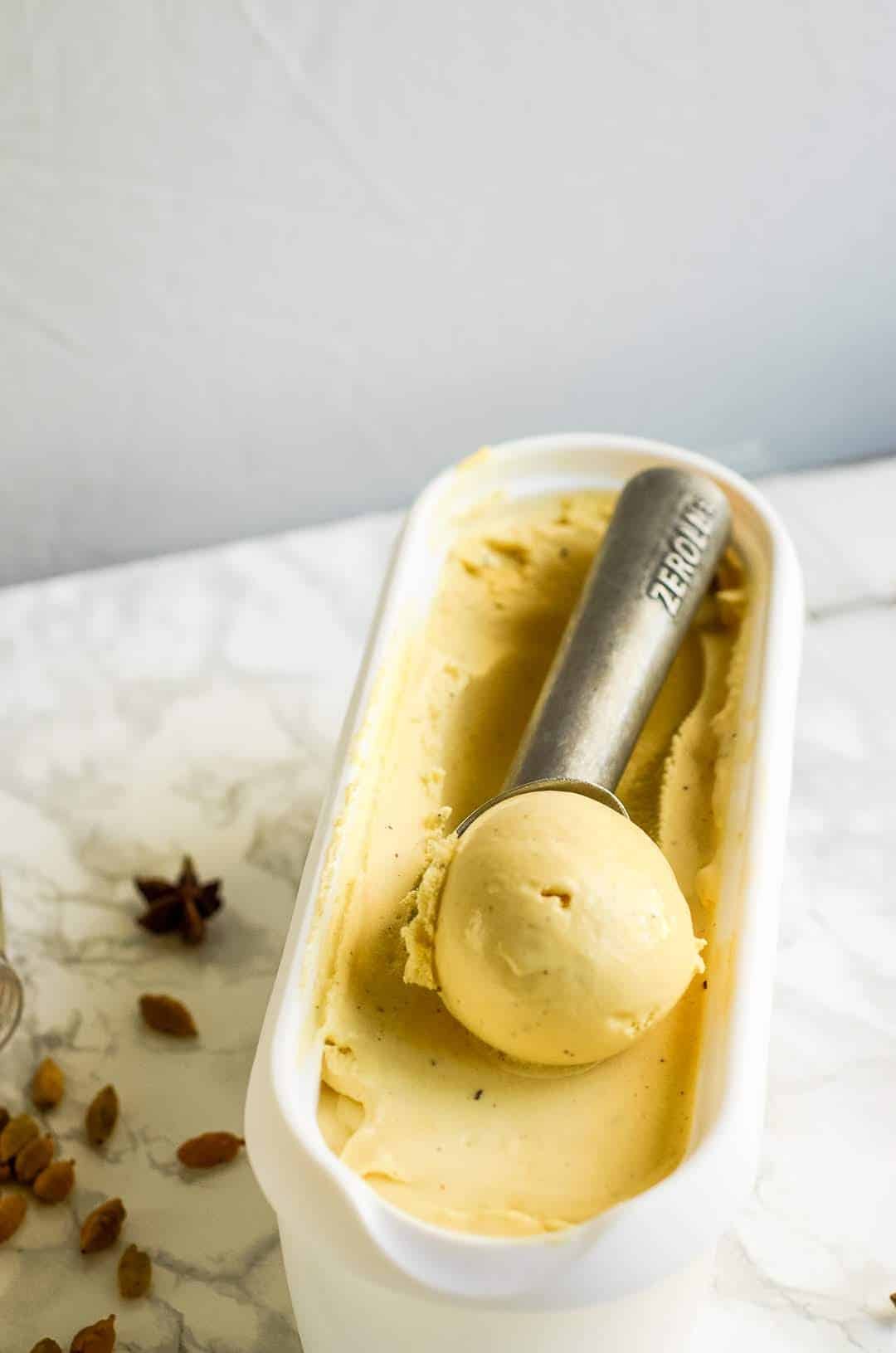
The Best Vanilla Custard Ice Cream Recipe
This is absolutely my favorite way to make custard ice cream. A lot of recipes tell you to cook the base directly in the pot. This recipe doesn't because the double boiler provides fine-tuned temperature control.
Using a double boiler gives you more temperature regulation since the base isn’t directly touching a heat source. It also gives you more ice cream at the end because less sticks to the pot.
If you would like to heat it up in a pot instead of the double boiler, no problem. I do still recommend adding the chilled heavy cream at the end to stop the cooking. This ensures your residual heat doesn’t overcook your base.
Use this printable grocery list for homemade vanilla frozen custard to make shopping simpler. All ingredients are listed in standard grocery store amounts. If no size is specified, even the smallest package will provide more than enough.
Thanks so much for stopping by!
Happy Cooking! 🙂
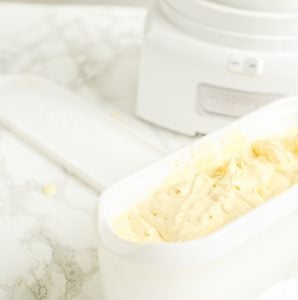
Homemade Custard Ice Cream
Ingredients
- 6 egg yolks
- ¾ cup granulated sugar
- 2 cups whole milk
- 1 cup heavy cream
- ½ teaspoon salt
- 1 teaspoon pure vanilla extract or vanilla bean paste, (optional)
Instructions
- Combine the egg yolks, sugar, and salt in a bowl. Whip the mixture until it becomes thick and the color turns a light yellow.
- Scald the milk in a pot, then gradually beat it into the egg mixture. If you add in too much too soon in will scramble your eggs. Take your time.
- Place the bowl over a water bath or double boiler*. Continue to heat, sitrring constantly, until the mixture is thick enough to coat the back of a spoon. (Or 160°F.)
- Immediately stir in the cold cream to stop the cooking. Add the vanilla if using.
- Chill the mixture for at least 12 hours, then freeze in an ice cream maker according to the manufacturer's directions.
- Place the ice cream in the freezer and freeze for 4 hours for a consistency similar to soft serve, or 12 hours for old-fashioned.
Notes
- If you are using a container of heavy cream that has previously been opened, make sure to scald and cool it prior to use. This will help reduce the risk of food-borne illness.
- To make a double boiler, you need a pot that can hold a bowl on top that is large enough to hold your custard base. Fill the pot with a couple inches of water, but not enough to touch the bottom of the bowl. Bring the water to a simmer and let the steam cook the contents of the bowl.
- If you add the cold cream and vanilla at the same time, the heat from the custard base will cook out some of the impact of the vanilla. For the biggest flavor impact, add the vanilla at the end.


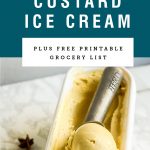
Jennifet says
Hmmm I found this very salty. I did get a creamy base and it was my first time making a cooked base for ice cream, so overall it was a success! But if my 6 year old refuses frozen custard, I know I did something wrong with the recipe.
Mackenzie Ryan says
Thanks so much for stopping by!
I updated the salt amount to be more palatable.
Happy Cooking!
Todd says
I was interested in what you said around the butter being introduced during the roasting. Are you saying you would just roast the almonds with butter to create butter almond ice custard. I am about to try a butter pecan other times I have had issues incorporating the butter in the recipe with our it becoming butter droplets.
Mackenzie Ryan says
Hi Todd! That's exactly it. If you roast the pecans with the butter, the butter flavor will get nice and toasty on the nuts and then dissolve into the custard base when you make the ice cream. I find it's the easiest way to get the butter flavor while avoiding the butter droplets you mentioned.
I hope that helps! Let me know how the ice cream turns out. 🙂
mary samaniego says
Hello, I love your recipe and I just got a new Ice Cream Maker today. I love buttered almond ice cream, not almond ice cream. How do I make it so it taste buttery?
Mackenzie Ryan says
Hi Mary! Thank you for the kind words. I hope you're loving your new ice cream maker! (Which one did you get?) In my experience, it's best to make "buttered almonds" rather than almond ice cream with butter. The butter in the roasting process will bring that flavor into the ice cream. I also prefer to use Amaretto with almond extract. It doesn't overpower the buttery flavor the same way.
I hope that helps. This recipe from Tutti Dolce seems to fit pretty closely with what I'd go for (but I'd totally still use my custard base). https://tutti-dolci.com/2017/06/butter-almond-ice-cream/. I hope that helps! Let me know how it goes! 🙂
Kiki Johnson says
Homemade ice cream is a must during the hot summer months! I am always curious to see how other foodies make their base and I am for sure going to try your method!
Mackenzie Ryan says
This makes such a delightful and decadent ice cream! I hope you like it!
Timid says
I had never made custard or icecream before this but this recipe sounded good even if a bit intimidating for a novice. It was amaaaazing and not as difficult as I had anticipated. Nothing curdled, no bits of weird cooked egg it was simply silky and luxurious. I swapped the vanilla out for almond extract and made a gorgeous Rhubarb Custard icecream!
It was quite sweet though, I'm wondering if it's possible to reduce the level of sugar a bit for next time or if that would completely destroy the texture. Regardless I would make this again and try different flavors or just plain...plain would be really good.
Mackenzie Ryan says
This just absolutely made my day! I love that you tried something new and that the recipe worked so well for you. Plus, that Rhubarb ice cream with almond extract sounds magnificent!!! Yum!!
As for the sweetness - you absolutely could cut it down a bit, I would say by as much as 1/3rd depending on what you are turning the base into. It may change the texture a bit, but mostly in how it freezes. Since you'll have more liquid in the recipe, the mouthfeel will vary slightly and it will be more prone to freezer burn. I recommend putting the ice cream into a freezer safe container, and then putting that container into a sealable freezer safe gallon bag. That usually does the trick!
I'm so glad you enjoyed the recipe, and thank you for the awesome review! If you get a chance, I'd love to see a photo of your delicious creation! 🙂
MEGAN MCDUFFIE says
What a great, well-researched post! I have yet to dip my toes into ice cream making, but this is a great guide for when I start! The ice cream recipe you suggested looks wonderful - I love anything with cardamom!
Mackenzie Ryan says
I hope you get to try making your own ice cream soon, Megan. The effort you put into it will definitely be rewarded with excellent creamy dreamy goodness!